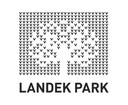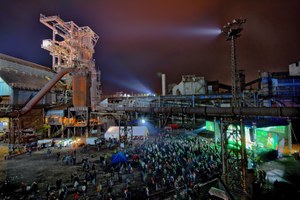The Vítkovice Lower Area
National Historic Landmark.
The Lower Vítkovice complex – a former heavy industrial site where production ceased in 1998 – covers a total area of 150 ha and is divided into three parts. In the northern part of the complex is the former Hlubina coal mine, blast furnaces, a coking plant and chemical plant. The central part of the complex was used for mechanical engineering, and the southern part was the site of a group of industrial and administrative buildings.
In the autumn of 2003 the complex was purchased by the Vítkovice corporation (Vítkovice a.s.). It is currently being revitalized and converted for a range of new uses as part of the New Vítkovice project. This project covers not only the former Vítkovice Ironworks site (which was active from 1828 to 1998), but also the neighbouring Hlubina coal mine, the nearby Karolina Triple Hall, and the Landek Park mining museum on the northern edge of Ostrava. The New Vítkovice project is the brainchild of Jan Světlík, CEO of the Vítkovice engineering corporation, and the architectural side of the project is coordinated by Josef Pleskot and his AP Studio.
As part of the project, a century-old derelict gas-holder has been converted into a congress centre and auditorium for 1 500 people, known as the Gong. This multifunctional structure also includes a space for the PLATO gallery. The nearby U6 power plant (built in 1911) has been transformed into an educational centre for science teaching, also known as the Small World of Technology. The Ostrava Science and Technology Centre (opened on 26 June 2014) has signed a cooperation agreement with the American Museum of Natural History in New York, one of the most prestigious institutions of its type in the world.
The Lower Vítkovice site is still in the process of being transformed into a multifunctional complex including leisure facilities, shopping, museums and galleries, residential blocks, research centres, student facilities and more. The projects involve a wide range of stakeholders including national government, the Moravian-Silesian Region, the City of Ostrava, the VŠB Technical University, and the University of Ostrava.
The revitalization of the complex also includes a number of infrastructure-related projects – the general infrastructure at the site (coordinated by the Lower Vítkovice Association), the energy centre (Vítkovice a.s.), the extension of Ruská Street (City of Ostrava), the regeneration of the Hlubina coal mine (Lower Vítkovice Association), and demolition work at Hlubina (Moravian-Silesian Region). The total cost of these projects is approx. 500-600 million CZK.
The total cost of the entire revitalization programme is currently around 1 billion CZK.
Project coordinator: Lower Vítkovice Association of Legal Entities (DOV)
GONG – multifunctional hall
This former gas-holder has been transformed into the ‘Gong’ multifunctional arena thanks to a bold and innovative design by the renowned architect Josef Pleskot and his AP Studio. With its unique use of space, ample capacity and state-of-the-art audiovisual technologies, the Gong is an ideal venue for educational events, large-scale congresses, concerts, and other social events. The first step in the conversion project was to raise the bell of the gas-holder to its highest position, accentuating the structure’s impressive dimensions. The second step was to insert structural elements inside the outer shell of the gas-holder without actually disrupting the original structure or materials – thus retaining the unique character of the site.
Total costs: 313 mil. CZK excl. VAT
Subsidy: 311 mil. CZK
Subsidy programme: IOP
Date of implementation/completion: 10/2010 – 11/2012, opening to the public 5/2012
Bolt Tower – Blast furnace no. 1
The ‘Bolt Tower’ is a unique structure added to the top of the historic blast furnace – so called because its spiral form resembles the screw-thread of a bolt. The tower forms part of the blast furnace tour route, and reaches a height of 80 metres above ground level. As well as offering breathtaking panoramic views (including the whole of Ostrava and the Beskydy Mountains to the south), the tower also has a sky café and a clubroom used for technology-related teaching. The tour route takes visitors through the heart of the blast furnace, showing how raw materials were transformed into molten iron. The tower (and the beginning of the tour route) is accessed by an elevator.
Total costs: 50 mil. CZK excl. VAT
Subsidy: 50 mil. CZK
Subsidy programme: IOP
Date of implementation/completion: 3/2011 – 2/2012, opening to the public 3/2012
U6 – Small World of Technology
The former ‘U6’ power plant now houses the Small World of Technology. Visitors can enjoy more than a hundred interactive displays presenting the scientific and technological milestones of the past two centuries. Designed around a Jules Verne theme, this attraction is perfect for all the family. It presents some of the most fascinating chapters in technical history – including steam engines, steel-making, space travel, and ocean diving. It is not really a museum in the traditional sense, but a wonderful educational playground, where visitors can learn all about science and technology in a fun, interactive way.
Total costs: 118 mil. CZK excl. VAT
Subsidy: 118 mil. CZK
Subsidy programme: IOP
Date of implementation/completion: 6/2011 – 11/2012, opening to the public 11/2012
STC – Large World of Technology
The Science and Technology Centre is aimed at all age groups. It offers a playful interactive look at some of the most exciting aspects of science, taking you on a memorable voyage of discovery. Combining education with fun, it has become a popular attraction for school groups as well as the general public. The displays and activities give fascinating insights into many different aspects of science and technology – you can explore the human body, travel back in time to experience the world of the mammoth-hunters, learn how rainbows or storm clouds work – and much, much more.
Total costs: 510-520 mil. CZK
Subsidy: precise sum not yet known
Subsidy programme: OP Research and Development for Innovations
Date of implementation/completion: 5/2012 – 9/2014, construction 5/2012 – 2/2014, exhibitions 3/2014 – 9/2014; project launched 12/2011
Landek Park
The Landek Park complex offers relaxation, entertainment and a great day out for all the family – including Ostrava’s famous mining museum. Visitors to the museum can ride on an original mine railway dating from the 1960s and go underground to experience the miners’ working conditions in a simulated tunnel. Afterwards you can sample deliciously authentic local specialities in a mining-themed restaurant. Situated on the outskirts of Ostrava, Landek Park is a popular recreational complex, offering pleasant strolls through spacious parkland, excellent sports facilities, and frequent cultural and social events.
Karolina Triple Hall
The ‘Triple Hall’ consists of a trio of historic former factory buildings which have been completely reconstructed and converted into an unusual multifunctional public space – almost like a city square, but under a huge roof. The complex includes sports facilities and a gallery, and it has become a popular venue for all kinds of events and activities organized by ordinary people from the local community – you can hire the space for a market, a concert, or even in-line skating in the middle of winter!
Hlubina Mine
MUSIC - FILM - ARTS - CRAFTS
The five historic buildings of the former Hlubina coal mine – listed as a national cultural monument in recognition of their outstanding heritage value – have been reconstructed to create a vibrant space for arts, culture, and creative activities. Whereas the revitalization projects at Lower Vítkovice have focused on science and technology, Hlubina is a beacon for the local arts scene.
 |  |  |  |  |
|---|


